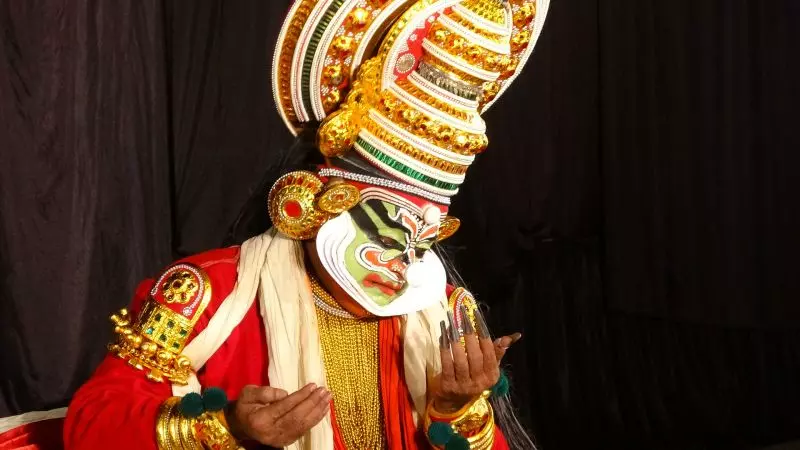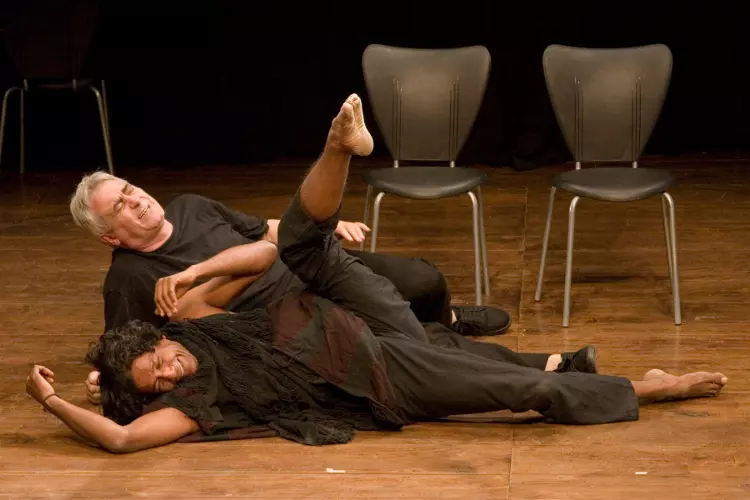
- Home
- India
- World
- Premium
- THE FEDERAL SPECIAL
- Analysis
- States
- Perspective
- Videos
- Sports
- Education
- Entertainment
- Elections
- Features
- Health
- Business
- Series
- In memoriam: Sheikh Mujibur Rahman
- Bishnoi's Men
- NEET TANGLE
- Economy Series
- Earth Day
- Kashmir’s Frozen Turbulence
- India@75
- The legend of Ramjanmabhoomi
- Liberalisation@30
- How to tame a dragon
- Celebrating biodiversity
- Farm Matters
- 50 days of solitude
- Bringing Migrants Home
- Budget 2020
- Jharkhand Votes
- The Federal Investigates
- The Federal Impact
- Vanishing Sand
- Gandhi @ 150
- Andhra Today
- Field report
- Operation Gulmarg
- Pandemic @1 Mn in India
- The Federal Year-End
- The Zero Year
- Science
- Brand studio
- Newsletter
- Elections 2024
- Events
How William Shakespeare’s plays have been adapted in India over the years

King Lear in Kathakali vesham. Check. Nick Bottom of A Midsummer Night’s Dream as a tribal performer speaking in the Bastar dialect. Check. A Manipuri-speaking Macbeth or Marathi-spouting Lady Macbeth. Check. William Shakespeare, the Bard of Avon, has been a fountain of inspiration for Indian playwrights, theatre directors, filmmakers and writers who have tapped into the universality of...
King Lear in Kathakali vesham. Check. Nick Bottom of A Midsummer Night’s Dream as a tribal performer speaking in the Bastar dialect. Check. A Manipuri-speaking Macbeth or Marathi-spouting Lady Macbeth. Check. William Shakespeare, the Bard of Avon, has been a fountain of inspiration for Indian playwrights, theatre directors, filmmakers and writers who have tapped into the universality of human emotions he explored in his plays: love, jealousy, ambition, revenge, and redemption. These are the themes that are, inarguably, as relevant in modern India — as indeed anywhere in the world — as they were in Elizabethan England.
Eminent Kannada playwright Girish Karnad (1938-2019) had famously admitted that it was Shakespeare who had influenced him the most. His own play, Tughlaq (1964), which takes a relook at medieval Delhi sultan Muhammad bin Tughlaq’s reign, while not a direct adaptation, shares thematic and structural resonances with Shakespeare’s historical plays, particularly Richard II and Macbeth. Like Shakespeare’s tragic heroes, Tughlaq is a complex and contradictory figure, driven by ambition, idealism, and a thirst for power; in the play, Karnad delves into the inner workings of his mind, exploring his motivations, his political strategies, and the psychological toll of his decisions.
Drawing parallels between Shakespeare’s characters and situations, and the realities of Indian society, these innovatively adapted works in post-independent India offer fresh points of entry into the Shakespearean text, his many comedies and tragedies. Over the years, Shakespeare’s plays have been reimagined and reinterpreted through the lens of our culture, language, and artistic forms. In Bengal, for instance, Utpal Dutt (1929-93), who acted in a lot of Hindi films, produced several of Shakespeare’s plays under his Calcutta-based Little Theatre Group: The Merchant of Venice (1953), Macbeth (1954), Julius Caesar (1957), Romeo and Juliet (1964) and A Midsummer Night’s Dream (Chaitali Rater Shopno in Bengali, 1964).
After abstaining from Shakespeare during the violence that rocked Bengal in the 1960s, ahead of the creation of Bangladesh, Dutt is believed to have done 98 performances of Macbeth in the Jatra style (the all-night, out-in-the-open performances, a departure from his restrained proscenium productions to cater to the elite) for villagers. Unlike his guru, British actor and theatre director Geoffrey Kendal who showcased Shakespeare’s timeless preoccupations, Dutt highlighted the core concerns of the time — class, education and the cultural moorings — in his productions aimed at rousing the audience from “unthinking stupor by sensation, visual surprise, songs, dances, colour.”
In 2003, Habib Tanvir (1923-2009), one of the doyens of Indian theatre, adapted A Midsummer Night’s Dream, a play set in ancient Athens and a magical forest, into Hindi as Kamdeo ka Apna Basant Ritu ka Sapna. Tanvir, who trained at the Royal Academy of Dramatic Art and the Old Vic, was a pioneer when it came to combining folk theatre and politics. He founded the Naya Theatre in 1959 with his wife, Moneeka Misra. For Kamdeo ka Apna…, Tanvir roped in tribal performers speaking in the Bastar dialect of Chhattisgarh. The characters used a hybrid of Hindi and the dialect of the tribals of the region; in his work, Tanvir set out to abolish the hierarchies between folk and class. In the play, he used folk improvisational techniques and music, and laced them with his own socialist (and comic) look at the Indian socio-political situations.
If Tanvir made the most of Bastar dialect, veteran Kannada playwright BV Karanth (1929-2002), an alumnus of National School of Drama (NSD), who later became its director, used Karnataka’s traditional folk dance form, Yakshagana, in his adaptation of Macbeth, Barnam Vana (Birnam Wood, 1979). The 1989 production of Kathakali-King Lear, technically, was not wholly Indian as it was the brainchild of French choreographer Annette Leday and Australian playwright David McRuvie, but when it was revived in 2018, Peesappilly Rajeevan, the Kathakali actor known for Ila (2021), The Cloud Messenger (2022) and Itharam (2019), received rave reviews as King Lear in kathi vesham make-up.

Peesappilly Rajeevan, the Kathakali actor known for Ila, The Cloud Messenger and Itharam, received rave reviews as King Lear in kathi vesham make-up.
Marathi theatre has adapted most of Shakespeare’s works since Independence, more than theatre in any other state. While Zunzarrao, GB Deval’s 1890 adaptation of Othello, is the most notable of them all, there are many others that can be listed here. VV Shirwadkar’s adaptation of Macbeth, Rajmukut (The Royal Crown) in 1954, featured Nanasaheb Phatak and Durga Khote). Then, there was Vinda Karandikar’s King Lear (1974). Manipur, too, has been a fertile site for ingenious adaptations in Meitei language. The most spectacular and imaginative of them all is Ratan Thiyam’s Macbeth (2014), mounted by Imphal’s Chorus Repertory Theatre. Powerful and haunting, it creates an unforgettable visual spectacle; swords, tribal costumes, headgear and beads, and the Manipuri music and song, particularly drums and a keening (wailing lament), enhanced its tragic ethos. Other notable Manipuri works include Lokendra Arambam’s Chingkhei Napa (Manipuri Macbeth, 1997), Ratan Kumar Singh’s Julius Caesar (2003), and Ranbir Mangang’s 2015 adaptation of the last.
English theatre in cities like Mumbai, Delhi, Kolkata and Bengaluru have seen many intelligent adaptations, including Alyque Padamsee’s Hamlet (1964) and Othello (1990), Vikram Kapadia and Naseeruddin Shah’s Julius Caesar (1992), Ananda Lal’s The Merchant of Venice (1997), Roysten Abel’s Othello: A Study in Black and White (1999-2000). Abel reimagines Shakespeare’s classic tragedy (Adil Hussain plays Othello, and Lushin Dubey Desdemona) in a contemporary Indian context. Centered on a group of Indian actors rehearsing Othello, it foregrounds social issues like class struggles, the urban-rural divide, the clash between the metropolis and small towns, and the conflict between Westernized and traditional Indian identities.

Roysten Abel’s Othello: A Study in Black and White reimagines Shakespeare’s classic tragedy in a contemporary Indian context.
Abel cleverly uses Shakespeare’s play as a backdrop to expose these underlying conflicts. By employing a multilingual (English, Hindi, and Assamese) approach, the play underscores India’s diversity. I’ll also add to this list Atul Kumar’s nautanki-style Piya Behrupiya, which was performed at the London Globe in April 2012 and then all across India to full houses.
In cinema and literature, too, the Bard has been an influence for many decades. One of the earliest Hindi films that betrays this influence is Dil Farosh (One Who Sells His Heart, 1927), based on The Merchant of Venice. In 1935, Sohrab Modi’s Khoon Ka Khoon (Blood for Blood) brought Hamlet to the Indian screen, and in 1948, Nargis’ portrayal of Juliet drew favourable comparisons to Norma Shearer’s performance in the 1936 Hollywood adaptation. Kishore Sahu’s Hamlet (1954) is another superhit classic movie. The Malayalam film, Kaliyattam (1997), is a reworking of Othello, in which racial conflict transforms into one based on caste among the members of a troupe of Kathakali performers. Shakespearean comedies have also found a home in Indian cinema. The Bengali film Bhranti Bilash (1963), based on Ishwar Chandra Vidyasagar’s translation of The Comedy of Errors and starring the legendary Uttam Kumar, is among the most memorable. This also inspired Gulzar’s Angoor (1982).
The tragic love story of Romeo and Juliet has inspired numerous Bollywood hits. Ek Duje Ke Liye (1981) explored the love between a Tamil man and a North Indian woman, while Qayamat Se Qayamat Tak (1988) and Ishaqzaade (2012) depicted star-crossed lovers from feuding families. The most-talked-about adaptations in recent years is Vishal Bhardwaj’s acclaimed trilogy — Maqbool (Macbeth), Omkara (Othello), and Haider (Hamlet) — marks a landmark contribution to Shakespeare in Indian cinema. Bhardwaj transposes these tragedies into the Indian milieu, exploring themes of power, revenge, and political intrigue with a distinctly Indian flavour.

Shahid Kapoor in Vishal Bhardwaj's Haider which is based on Hamlet.
A few years ago, I read a novel — Preti Taneja’s We That Are Young — that stayed with me. A modern-day reimagining of Shakespeare’s King Lear set against the dazzling chaos of contemporary India’s corporate, it weaves together corporate greed, family dysfunction, and social unrest. Taneja’s characters are richly drawn and complex, each grappling with their own desires, ambitions, and vulnerabilities. The patriarch, Devraj, a ruthless billionaire businessman, echoes Lear’s tragic flaws as he divides his empire among his three daughters, setting in motion a chain of events that will lead to their downfall.
The novel’s setting, a sprawling metropolis rife with corruption and inequality, serves as a stark backdrop to the characters’ personal struggles. Taneja depicts the stark contrasts between the opulent lives of the elite and the harsh realities faced by the marginalised, exposing the deep-rooted social injustices in India. The language is poetic and evocative, the writing insightful and visceral. While it draws inspiration from King Lear, the novel is not a mere retelling. Taneja infuses and inflects the story with contemporary Indian themes and concerns.
Shakespeare’s plays are timeless — this is no act of bardolatory, but a fact — but they get a new life in India. Through these adaptations, Shakespeare’s legacy is not merely preserved but reborn.
